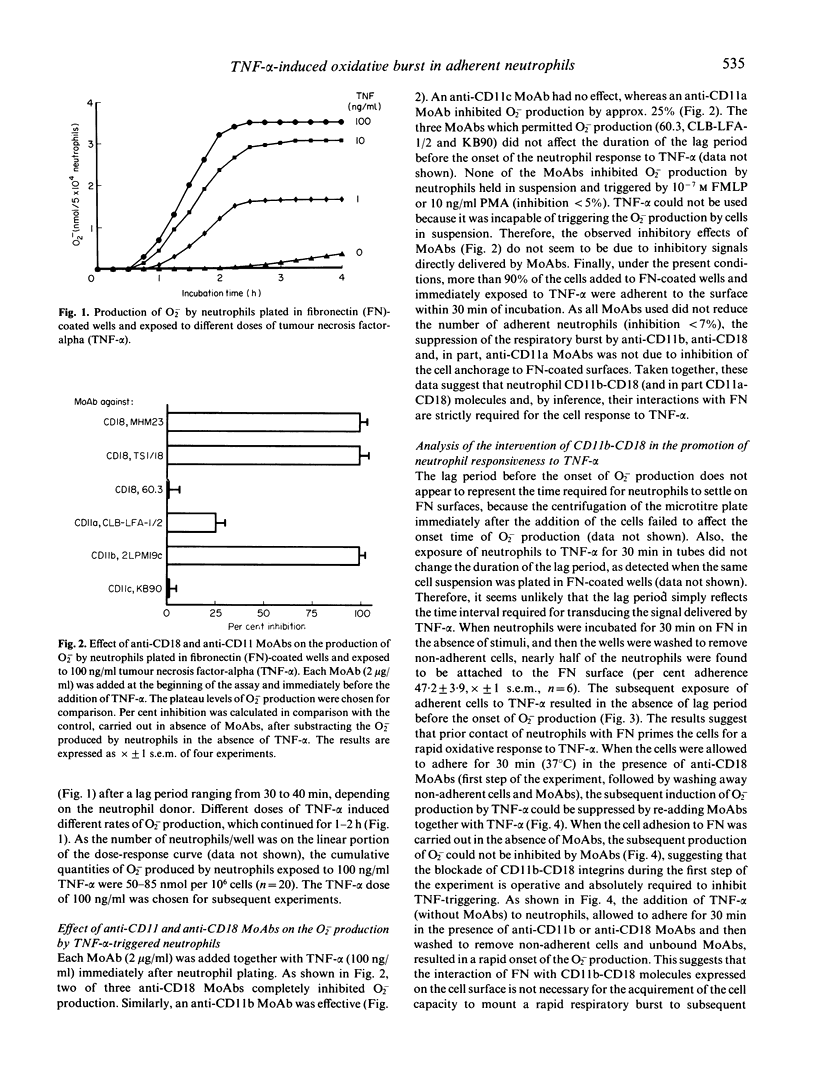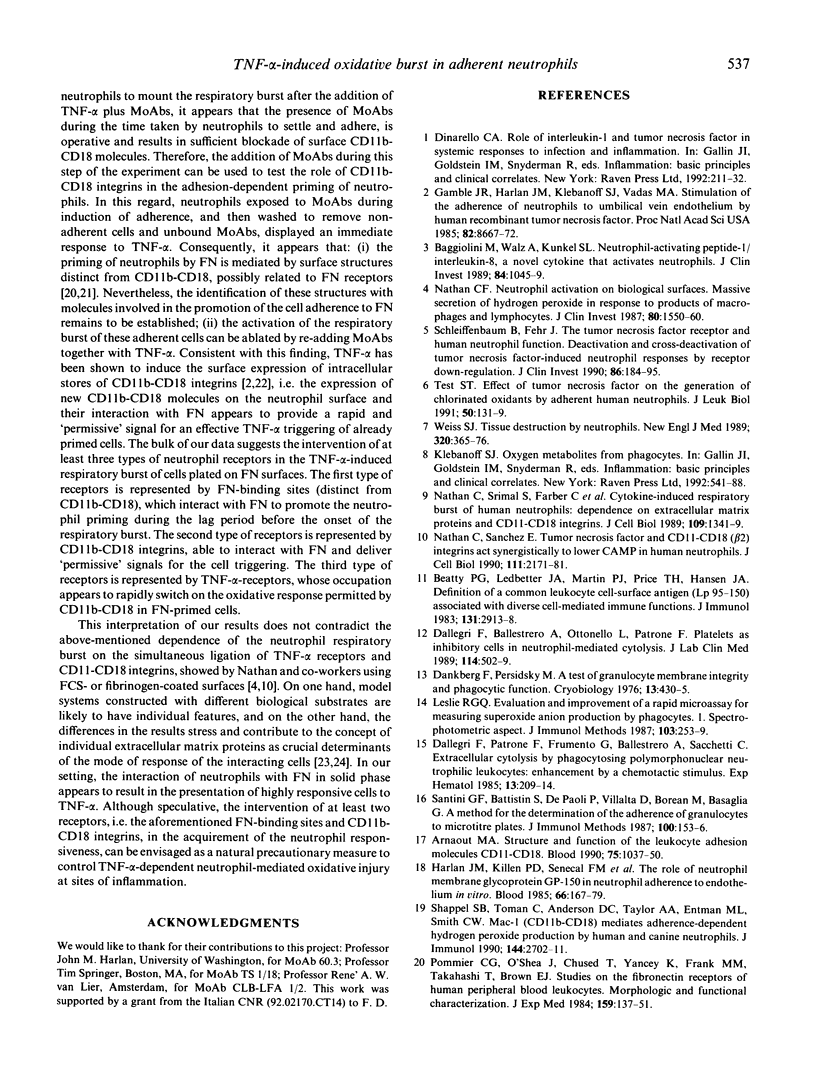Abstract
Human neutrophils, added to fibronectin (FN)-coated polystyrene wells and exposed to tumour necrosis factor-alpha (TNF-alpha), were found to exhibit a prolonged production of superoxide anion (O2-) after a lag period of approx 30 min. The O2- production, but not the cell adherence to FN, was completely inhibited by two MoAbs against CD18 and by a MoAb against CD11b, suggesting the involvement of CD11b-CD18 integrins in the neutrophil oxidative response. When neutrophils were induced to adhere to FN by incubation for 30 min on FN-coated surfaces and then washed to remove non-adherent cells, FN-anchored cells exhibited a rapid onset of O2- production in response to TNF-alpha. This suggests that FN primes neutrophils for the TNF-alpha-mediated respiratory burst. The O2- production by adherent neutrophils could be inhibited by anti-CD11b and anti-CD18 MoAbs only when the MoAbs were present both during the induction of adherence and during the subsequent exposure of FN-bound cells to TNF-alpha. The incapacity of MoAbs, added to neutrophils during the induction of adherence, to modify the characteristics of the subsequent neutrophil response to TNF-alpha suggests that the FN-mediated cell priming is independent of the interaction of CD11b-CD18 integrins with the FN substrate. The results are consistent with the intervention of three classes of cell receptors in the TNF-alpha-induced oxidative burst of neutrophils plated on FN: (i) neutrophil FN-binding sites, distinct from CD11b-CD18 and responsible for the cell priming; (ii) CD11b-CD18 integrins, absolutely required for permitting the cell triggering; and (iii) TNF-alpha receptors, responsible for switching on a rapid cell response in primed cells. The requirement of multiple classes of receptors for the full expression of the cell function can be envisaged as a natural precautionary measure to control the neutrophil responsiveness to TNF-alpha and, in turn, the TNF-alpha-dependent neutrophil-mediated oxidative injury at sites of inflammation.
Full text
PDF





Selected References
These references are in PubMed. This may not be the complete list of references from this article.
- Arnaout M. A. Structure and function of the leukocyte adhesion molecules CD11/CD18. Blood. 1990 Mar 1;75(5):1037–1050. [PubMed] [Google Scholar]
- Baggiolini M., Walz A., Kunkel S. L. Neutrophil-activating peptide-1/interleukin 8, a novel cytokine that activates neutrophils. J Clin Invest. 1989 Oct;84(4):1045–1049. doi: 10.1172/JCI114265. [DOI] [PMC free article] [PubMed] [Google Scholar]
- Beatty P. G., Ledbetter J. A., Martin P. J., Price T. H., Hansen J. A. Definition of a common leukocyte cell-surface antigen (Lp95-150) associated with diverse cell-mediated immune functions. J Immunol. 1983 Dec;131(6):2913–2918. [PubMed] [Google Scholar]
- Brown E. J., Goodwin J. L. Fibronectin receptors of phagocytes. Characterization of the Arg-Gly-Asp binding proteins of human monocytes and polymorphonuclear leukocytes. J Exp Med. 1988 Mar 1;167(3):777–793. doi: 10.1084/jem.167.3.777. [DOI] [PMC free article] [PubMed] [Google Scholar]
- Dallegri F., Ballestrero A., Ottonello L., Patrone F. Platelets as inhibitory cells in neutrophil-mediated cytolysis. J Lab Clin Med. 1989 Nov;114(5):502–509. [PubMed] [Google Scholar]
- Dallegri F., Patrone F., Frumento G., Ballestrero A., Sacchetti C. Extracellular cytotoxicity by phagocytosing polymorphonuclear neutrophilic leukocytes: enhancement by a chemotactic stimulus. Exp Hematol. 1985 Mar;13(3):209–214. [PubMed] [Google Scholar]
- Dankberg F., Persidsky M. D. A test of granulocyte membrane integrity and phagocytic function. Cryobiology. 1976 Aug;13(4):430–432. doi: 10.1016/0011-2240(76)90098-5. [DOI] [PubMed] [Google Scholar]
- Gamble J. R., Harlan J. M., Klebanoff S. J., Vadas M. A. Stimulation of the adherence of neutrophils to umbilical vein endothelium by human recombinant tumor necrosis factor. Proc Natl Acad Sci U S A. 1985 Dec;82(24):8667–8671. doi: 10.1073/pnas.82.24.8667. [DOI] [PMC free article] [PubMed] [Google Scholar]
- Griffin J. D., Spertini O., Ernst T. J., Belvin M. P., Levine H. B., Kanakura Y., Tedder T. F. Granulocyte-macrophage colony-stimulating factor and other cytokines regulate surface expression of the leukocyte adhesion molecule-1 on human neutrophils, monocytes, and their precursors. J Immunol. 1990 Jul 15;145(2):576–584. [PubMed] [Google Scholar]
- Harlan J. M., Killen P. D., Senecal F. M., Schwartz B. R., Yee E. K., Taylor R. F., Beatty P. G., Price T. H., Ochs H. D. The role of neutrophil membrane glycoprotein GP-150 in neutrophil adherence to endothelium in vitro. Blood. 1985 Jul;66(1):167–178. [PubMed] [Google Scholar]
- Hynes R. O. Integrins: versatility, modulation, and signaling in cell adhesion. Cell. 1992 Apr 3;69(1):11–25. doi: 10.1016/0092-8674(92)90115-s. [DOI] [PubMed] [Google Scholar]
- Leslie R. G. Evaluation and improvement of a rapid microassay for measuring superoxide anion production by phagocytes. 1. Spectrophotometric aspects. J Immunol Methods. 1987 Nov 5;103(2):253–259. doi: 10.1016/0022-1759(87)90297-3. [DOI] [PubMed] [Google Scholar]
- Nathan C. F. Neutrophil activation on biological surfaces. Massive secretion of hydrogen peroxide in response to products of macrophages and lymphocytes. J Clin Invest. 1987 Dec;80(6):1550–1560. doi: 10.1172/JCI113241. [DOI] [PMC free article] [PubMed] [Google Scholar]
- Nathan C., Sanchez E. Tumor necrosis factor and CD11/CD18 (beta 2) integrins act synergistically to lower cAMP in human neutrophils. J Cell Biol. 1990 Nov;111(5 Pt 1):2171–2181. doi: 10.1083/jcb.111.5.2171. [DOI] [PMC free article] [PubMed] [Google Scholar]
- Nathan C., Sporn M. Cytokines in context. J Cell Biol. 1991 Jun;113(5):981–986. doi: 10.1083/jcb.113.5.981. [DOI] [PMC free article] [PubMed] [Google Scholar]
- Nathan C., Srimal S., Farber C., Sanchez E., Kabbash L., Asch A., Gailit J., Wright S. D. Cytokine-induced respiratory burst of human neutrophils: dependence on extracellular matrix proteins and CD11/CD18 integrins. J Cell Biol. 1989 Sep;109(3):1341–1349. doi: 10.1083/jcb.109.3.1341. [DOI] [PMC free article] [PubMed] [Google Scholar]
- Pommier C. G., O'Shea J., Chused T., Yancey K., Frank M. M., Takahashi T., Brown E. J. Studies on the fibronectin receptors of human peripheral blood leukocytes. Morphologic and functional characterization. J Exp Med. 1984 Jan 1;159(1):137–151. doi: 10.1084/jem.159.1.137. [DOI] [PMC free article] [PubMed] [Google Scholar]
- Santini G. F., Battistin S., De Paoli P., Villalta D., Borean M., Basaglia G. A method for the determination of the adherence of granulocytes to microtitre plates. J Immunol Methods. 1987 Jun 26;100(1-2):153–156. doi: 10.1016/0022-1759(87)90184-0. [DOI] [PubMed] [Google Scholar]
- Schleiffenbaum B., Fehr J. The tumor necrosis factor receptor and human neutrophil function. Deactivation and cross-deactivation of tumor necrosis factor-induced neutrophil responses by receptor down-regulation. J Clin Invest. 1990 Jul;86(1):184–195. doi: 10.1172/JCI114683. [DOI] [PMC free article] [PubMed] [Google Scholar]
- Shappell S. B., Toman C., Anderson D. C., Taylor A. A., Entman M. L., Smith C. W. Mac-1 (CD11b/CD18) mediates adherence-dependent hydrogen peroxide production by human and canine neutrophils. J Immunol. 1990 Apr 1;144(7):2702–2711. [PubMed] [Google Scholar]
- Test S. T. Effect of tumor necrosis factor on the generation of chlorinated oxidants by adherent human neutrophils. J Leukoc Biol. 1991 Aug;50(2):131–139. doi: 10.1002/jlb.50.2.131. [DOI] [PubMed] [Google Scholar]
- Weiss S. J. Tissue destruction by neutrophils. N Engl J Med. 1989 Feb 9;320(6):365–376. doi: 10.1056/NEJM198902093200606. [DOI] [PubMed] [Google Scholar]


